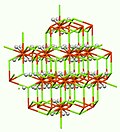 | |
| Names | |
|---|---|
| IUPAC name potassium hexafluoronickelate(IV) | |
| Identifiers | |
| |
3D model (JSmol) | |
| ChemSpider | |
| ECHA InfoCard | 100.153.655 |
| EC Number |
|
CompTox Dashboard (EPA) | |
| |
| |
| Properties | |
| K2NiF6 | |
| Molar mass | 250.880 |
| Hazards [1] | |
| GHS labelling: | |
   | |
| Danger | |
| H302, H312, H317, H331, H350 | |
| P201, P261, P280, P304+P340, P405, P501 | |
| Safety data sheet (SDS) | External SDS |
Except where otherwise noted, data are given for materials in their standard state (at 25 °C [77 °F], 100 kPa). | |
Potassium hexafluoronickelate(IV) is an inorganic compound with the chemical formula K
2NiF
6. It can be produced through the reaction of potassium fluoride, nickel dichloride, and fluorine.
It reacts violently with water, releasing oxygen. It dissolves in anhydrous hydrogen fluoride to produce a light-red solution. Potassium hexafluoronickelate(IV) decomposes at 350 °C, forming potassium hexafluoronickelate(III), nickel(II) fluoride, and fluorine: [2] [ better source needed ] [3]

Potassium hexafluoronickelate is a strong oxidant. It can turn chlorine pentafluoride and bromine pentafluoride into ClF+
6 and BrF+
6, respectively: [4]
- ( X = Cl or Br , -60 °C , aHF = anhydrous hydrogen fluoride).
Potassium hexafluoronickelate decomposes at high temperatures to release fluorine gas; like terbium(IV) fluoride, the emitted fluorine is primarily monatomic rather than the typical diatomic. [5]
It adopts the structure seen for K2PtCl6 and Mg2FeH6. [6]

